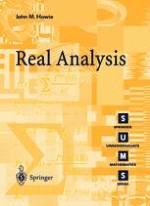
2001 | OriginalPaper | Buchkapitel
Introductory Ideas
verfasst von : John M. Howie, CBE, MA, D.Phil, DSc, Hon D.Univ, FRSE
Erschienen in: Real Analysis
Verlag: Springer London
Enthalten in: Professional Book Archive
Aktivieren Sie unsere intelligente Suche, um passende Fachinhalte oder Patente zu finden.
Wählen Sie Textabschnitte aus um mit Künstlicher Intelligenz passenden Patente zu finden. powered by
Markieren Sie Textabschnitte, um KI-gestützt weitere passende Inhalte zu finden. powered by
In writing this book my assumption has been that you have encountered the fundamental ideas of analysis (function, limit, continuity, differentiation, integration) in a standard course on calculus. For many purposes there is no harm at all in an informal approach, in which a continuous function is one whose graph has no jumps and a differentiable function is one whose graph has no sharp corners, and in which it is “obvious’ that (say) the sum of two or more continuous functions is continuous. On the other hand, it is not obvious from the graph that the function f defined by $$ f(x) = \left\{ {\begin{array}{*{20}c} {x sin(1/x)} & {if x \ne 0} \\ 0 & {if x \ne 0} \\ \end{array} } \right. $$ is continuous but not differentiable at x=0, since the function takes the value 0 infinitely often in any interval containing 0, and so it is not really possible to draw the graph properly.